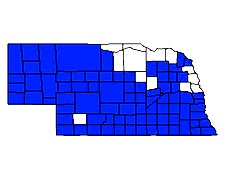Punctured Tiger Beetle |
|
Pictured Below:
Cicindela punctulata punctulata




Pictured Below:
Cicindela punctulata punctulata x punctulata chihuahuae





|
|
| |
|
|
 |
 |
| Cicindela punctulata punctulata Olivier |
| Adult Length: 10.5 to 15 m |
| Appearance: Adults of this species are typically dark purplish to blackish purple in color. As one goes southwestward in Nebraska, greenish and bluish individuals become more frequent. Occasional far southwestern individuals may be brilliant green or blue. Markings may be completely lacking, but usually consist of from two to sixteen very small white dots. In some cases these dots may be fused to form a complete apical lunule and/or a complete bent middle band. Upon close examination, a row of tiny bluish pits is evident near the elytral suture, thus the species name, punctulata. |
| Similar Species: There are several species with which this one could be confused. All of them lack the row of tiny pits on each elytron near the suture. |
| Biology: This is the tiger beetle species most likely to be noticed by the average person. It has often been called the “sidewalk tiger beetle” because adults are often seen foraging on sidewalks. Adults can be found in a wide variety of habitats including open fields with scattered bare patches, pastures, roadsides, lawns with bare patches, and the edges of salt flats. During dry periods in summer, adults may often be seen near water alongside C. repanda. In common with many summer species, adults are attracted to lights and can often be seen by the dozens gas stations, foraging on the pavement. Adults are quite skittish and relatively quick fliers, but only seldom fly more than 10 meters when alarmed. |
| Adult Life History: Adults begin to appear in the second half of June and the species is usually abundant by early July. As with other summer species, the peak activity period is somewhat variable. Unlike most other summer species numbers do not decline rapidly by August. Adults remain common into fall, and occasional individuals survive well into October. It is a summer species. |
| Larval Life History: Larvae can be found in a variety of areas, but are usually found in hard-packed soils. The vertical burrows are not uncommon in tiny bare patches in lawns and will occur in just about any hard-packed soil area that is somewhat free of vegetation. Unlike many other tiger beetle species, larval burrows normally do not occur in high densities, but are instead usually scattered across broad areas. A personal estimate would be that the average lawn in Kearney has two to three larval burrows per year. Of course this means that many lawns lack this species while others (particularly poorly maintained lawns) may have a significant number. Third instar burrows are usually about 15 to 20 cm in depth. It is a relatively easy species to fish out using a thin blade of grass. The life cycle is usually completed in one year, but as adults may lay eggs into fall, some larvae may require two years of development. In Buffalo County, about 10% of larvae do not reach the third instar by fall. Most eggs are laid in July and August, and most larvae reach the third instar by fall before overwintering. Larvae resume activity in spring, and pupation begins in late May and early June. |
| Biogeography: This species is abundant throughout the state. It is by far the most likely tiger beetle to be encounter by the average person. It probably occurs in every county in the state. Surveys conducted in 2004 revealed it in every county surveyed after early June. Greenish and bluish individuals encountered in the western half of the state represent intergrades with C. punctulata chihuahuae, a green-colored southwestern subspecies. In North America it is a abundant species across most of the United States, but is lacking from most areas west of the Rocky Mountains except the Desert Southwest, where it is highly associated with water. It is lacking from most of Canada, but does range well into Mexico. Three subspecies have been described. |
|










